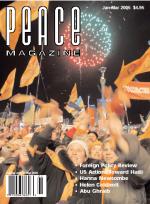
Peace Magazine Jan-Mar 2005, page 29. Some rights reserved.
Search for other articles by Joanna Santa Barbara here
A World Bank Policy Research Report by Paul Collier, V.L.Elliot, Havard Hegre, Anke Hoeffler, Marta Reynal-Querol, Nicholas Sambanis. World Bank and Oxford University Press, 2003.
There aren't many books on peace that cause you to read into the night to see what's coming next. This book is one. The reason you might wish to read this book is a proposal on its last page:
Referring to the Millennium Development Goals to reduce global poverty, ...the international community could adopt the same approach to reducing the incidence of civil war as it has to the objective of reducing world poverty. It could set a target, such as halving the incidence of civil war by 2015; adopt a strategy; and monitor the outcomes. ...Feasible strategies are available that if implemented are likely to make the target attainable.
This, you will agree, is a remarkable proposal. Also remarkable is its source, a team working under the chief economist of the World Bank.
The book is a report of extensive research on the economic and demographic correlates of war, leading to policy recommendations specific to a range of players. By "conflict," they mean "violent conflict."
The first several chapters of the book detail the human economic costs of civil wars. They have produced very interesting data: the average civil war lasts for seven years; approximately half the loss of disability-adjusted years of life-expectancy due to a conflict arise after it is over; although grievances about economic policy, democratic institutions or political freedom may have fuelled the war, all three usually deteriorate during and after a civil war; high military expenditure and capital flight persist for years after the war, contributing to the reversal of development of human well-being that is so tragically characteristic of civil wars in poor countries.
Examination of impact of civil war on neighboring countries shows an increase in military expenditure and depression in economic growth. Refugees suffer multiple health problems, and transmit some of them (such as malaria) to host populations. The outer ring of suffering from civil war is global in that civil war settings are successful substrates for the drug trade, the spread of HIV/AIDS and for terrorist organizations. According to the authors these adverse effects give the international community the moral right to prevent and shorten civil war. I would think that the extreme local human suffering is a far more compelling moral reason.
The next chapters ask what makes a country prone to civil war and why it is such a common phenomenon. It is in these chapters that the concept of "the conflict trap" is explained -- war and poverty form a vicious cycle spiralling down; each increases the probability or degree of the other. We encounter the upsetting datum that a country at the end of a civil war has a 44% chance of erupting into violence again in the next five years. The answers of this team to "why?" are very interesting. They do not dismiss the importance of political grievances in motivating violent responses, but point out that in most countries there are grievances, some severe, and only in some situations is violence used to deal with them. They focus particularly on opportunity to create and arm a rebel force. Pre-existing poverty of the population is a strong correlate of civil wars; inequality is not, though it correlates with length of the war. The capacity of factions to capture trade in exportable commodities has been shown to be a robust correlate of civil wars. This enables the support and arming of a military force, and comes to provide another issue for armed violence. Identity issues can be used to increase motivation to harm when a country has large divided ethnicities. Large or rich diasporas who can fund militias increase the risk.
Remaining chapters detail policy recommendations specific to a range of players. Strategies to escape and avoid "the conflict trap" are outlined. The focus is on economic policies addressing poverty as a determinant of war. The use of aid to reinforce existing democratic institutions is discussed. Ways are considered for increasing transparency of natural resource revenues, to prevent market capture by rebel organizations, and to prevent undemocratic use on military expenditures by governments. Means of shutting armed groups out of market benefit from resources, such as the "conflict diamonds" which get processed by Kimberly. The report promotes lowering of military expenditures. It then ends with the ringing challenge mentioned above, to halve the global incidence of civil war by 2015.
My criticisms are that this is the World Bank, of course. There is no mention of the other kind of war -- the US aggression to dominate and capture natural resource markets. The authors naturally emphasize economic factors and deemphasize political ones. There is no mention of the effect of economic globalization as a cause of violent conflict, in Chiapas, for instance. You will read nothing here of the role of nongovernmental organizations, even those focusing on economic development, and nothing of those focusing on peace. There is very little mention of the nonviolent management of conflicts and grievances by democracy and human rights protection. In a way this increases the significance of this work. These serious scholars hold that the incidence of civil war could be halved by tackling just economic factors. What if all the other possibilities were added on to these?
Reviewed by Joanna Santa Barbara, a Hamilton-based psychiatrist.

Peace Magazine Jan-Mar 2005, page 29. Some rights reserved.
Search for other articles by Joanna Santa Barbara here